1. Overview
Maria Christina Henriette Desideria Felicitas Raineria of Austria, known to her family as Christa, was a pivotal figure in Spanish history, serving first as Queen of Spain from 1879 to 1885 as the second wife of Alfonso XII of Spain, and then as Queen Regent from 1885 to 1902. Born on July 21, 1858, in Moravia, her life was marked by a deep sense of duty and a commitment to preserving the Spanish monarchy during a period of significant political transition and imperial decline. Her regency was crucial in ensuring the stability of the crown for her posthumous son, Alfonso XIII of Spain, navigating complex domestic politics and the devastating loss of Spain's remaining overseas territories. Maria Christina's steadfast dedication to constitutional order and her efforts to maintain political balance were instrumental in guiding Spain through a challenging era, reflecting a perspective that values stability and responsible governance. She passed away on February 6, 1929, in Madrid.
2. Early life and background
Maria Christina's early life was shaped by her prestigious Habsburg lineage and a rigorous upbringing that prepared her for a life of public service.
2.1. Birth and family
Maria Christina was born on July 21, 1858, at Židlochovice Castle (Groß Seelowitz), near Brno in Moravia, which was then part of the Austrian Empire. She was a daughter of Archduke Karl Ferdinand of Austria and his wife, Archduchess Elisabeth Franziska of Austria. Her paternal grandparents were Archduke Charles, Duke of Teschen, a notable military commander, and Princess Henriette Alexandrine of Nassau-Weilburg. Her maternal grandparents were Archduke Joseph, Palatine of Hungary, and Duchess Maria Dorothea of Württemberg. Through both her parents, she was a great-granddaughter of Leopold II, Holy Roman Emperor, highlighting her strong connection to the Habsburg and other prominent European royal houses. She was also a half-sister to Maria Theresia of Austria-Este, who became Queen of Bavaria.
2.2. Education and early career
Maria Christina was described by various sources as "tall, fair, sensible, and well educated," possessing qualities of justice and straightforwardness within the Austrian court. Her upbringing emphasized intellectual and moral development. From 1875 to 1879, she held the significant ecclesiastical position of Princess-Abbess of the Theresian Royal and Imperial Ladies Chapter of Prague Castle. This role provided her with early administrative experience and further solidified her reputation for piety and discipline, qualities that would later define her regency in Spain.
3. Life as Queen Consort
Maria Christina's marriage to King Alfonso XII was primarily a dynastic and political arrangement aimed at securing the future of the Spanish monarchy.
3.1. Marriage and accession
Following the death of his first wife, Mercedes of Orléans, in June 1878, King Alfonso XII of Spain was determined to remarry quickly to produce a male heir and ensure dynastic continuity. Negotiations began with the Imperial and Royal Court of Vienna. In August 1878, Alfonso XII traveled to Arcachon, Gironde, where he met Archduchess Maria Christina and her mother, Archduchess Elisabeth. During this initial meeting, the King proposed, and Maria Christina accepted.
In early September 1878, the Spanish Government formally approved the engagement. Emperor Franz Joseph I of Austria then requested his niece to officially relinquish her title as Abbess of the Theresian Convent of Prague, a necessary step for her to become a foreign queen. The engagement was publicly announced in the Wiener Zeitung on September 7. In compliance with Article 56 of the Spanish Constitution of 1876, the Cortes passed a law on November 2, granting a 500.00 K ESP annuity for the future queen consort. The specific terms of the marriage were formalized in an agreement between Austria and Spain, signed in Vienna on November 15. On the same day, Maria Christina formally renounced her succession rights to the Austrian throne, adhering to the tradition for archduchesses marrying foreign princes. A final marriage agreement was signed in Madrid by the King and Maria Christina themselves on November 28.
The wedding ceremony took place on November 29, 1879, at the Basilica of Nuestra Señora de Atocha in Madrid. This arranged marriage, Alfonso XII's second, was strategically designed to align with the conservative profile espoused by the Austro-Hungarian Empire and to leverage the historical prestige of the House of Habsburg in Spain. This union also served to undermine any potential Austrian support for the Carlist cause, further consolidating the Bourbon monarchy.

3.2. Children
Maria Christina and Alfonso XII had three children, whose births were crucial for the stability of the Spanish dynasty:
- María de las Mercedes (born 1880), who became Princess of Asturias. She married Prince Carlos of Bourbon-Two Sicilies and died in 1904, shortly after giving birth to her youngest child, Isabella. Her death is widely believed to have been caused by puerperal fever.
- María Teresa (born 1882), who married Prince Ferdinand of Bavaria. She died in 1912, also shortly after childbirth, likely due to puerperal fever.
- Alfonso (born May 17, 1886), who would become King Alfonso XIII.
The birth of two daughters initially fulfilled part of the dynastic need, but with the recent memory of the Carlist Wars threatening the ruling dynasty, Maria Christina faced considerable pressure to conceive and give birth to a male child. A male heir was seen as essential to consolidate the political system and ensure the long-term stability of the monarchy. She became pregnant again before her husband's death in November 1885. King Alfonso XII, despite suffering from tuberculosis, maintained an active life until his passing.

4. Regency
Maria Christina's period as Regent of Spain was a defining chapter in her life and in Spanish history, marked by her steadfast leadership during a time of profound challenges.
4.1. Beginning of the Regency
King Alfonso XII died on November 25, 1885. At the time of his death, Maria Christina was pregnant with their third child. This created a unique situation where the throne was vacant, as the succession depended on the gender of the unborn child: if it was male, that child would be king from birth; if female, the elder daughter, Princess of Asturias María de las Mercedes, would ascend the throne. During this interim period, Maria Christina immediately assumed the role of Regent.
On December 30, 1885, Maria Christina formally swore allegiance to the Spanish Constitution of 1876 at the Palacio de las Cortes, before both legislative bodies. She deliberately rejected the title of reina gobernadoraSpanish ("Queen Governor"), a title previously used by Maria Christina of Bourbon-Two Sicilies in the 1830s. By avoiding this title, she sought to distance her regency from the controversies and political turmoil associated with her predecessor, emphasizing a more constitutional and less absolute approach to governance. On May 17, 1886, she gave birth to a son, Alfonso, who immediately became King Alfonso XIII of Spain upon his birth, thereby securing the dynastic succession. Maria Christina continued to serve as Regent until her son came of age in May 1902.
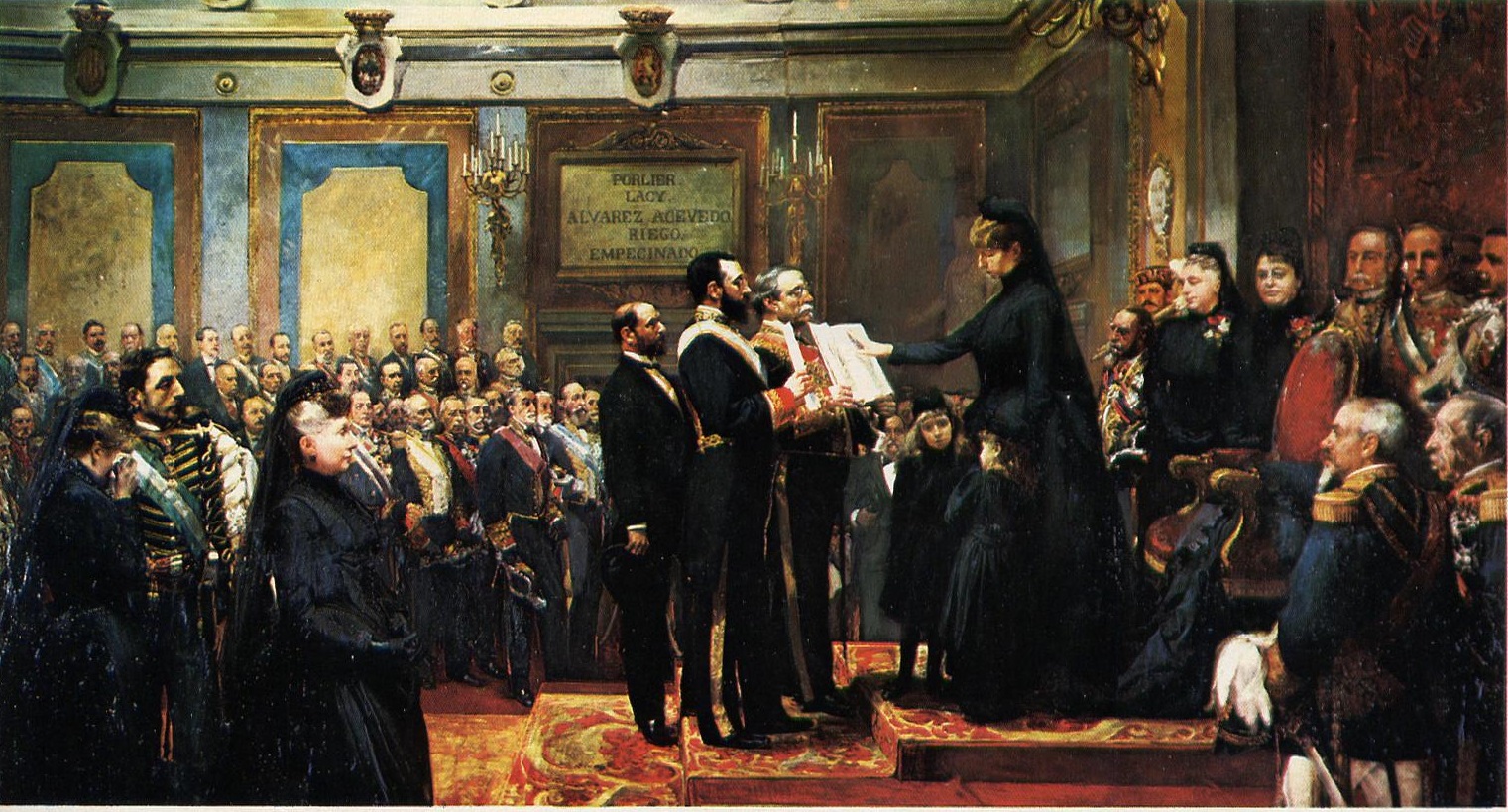
4.2. Rule as Regent
As Regent, Maria Christina cultivated a public persona characterized by austerity and staidness. She became widely known among the populace by nicknames such as Doña VirtudesSpanish ("Lady Virtues"), María la SecaSpanish ("Mary the Curt One"), and la institutrizSpanish ("the governess"). These sobriquets reflected both her perceived moral rectitude and her somewhat reserved, disciplined demeanor. Her strong religious beliefs garnered the endorsement of Pope Leo XIII, which significantly helped to weaken adherence to Carlism within the Spanish clergy, a crucial step in consolidating the monarchy's support base.
Her chief advisor and head of government during much of her regency was Práxedes Mateo Sagasta, a prominent liberal politician. Her rule is generally described as well-balanced and marked by a deep respect for constitutional rights. Many political reforms were initiated during her regency, specifically aimed at preventing political conflicts and maintaining constitutional order and stability. While her role was largely ceremonial, her primary purpose was to safeguard the crown for her son until he reached adulthood, a task she executed with unwavering dedication.
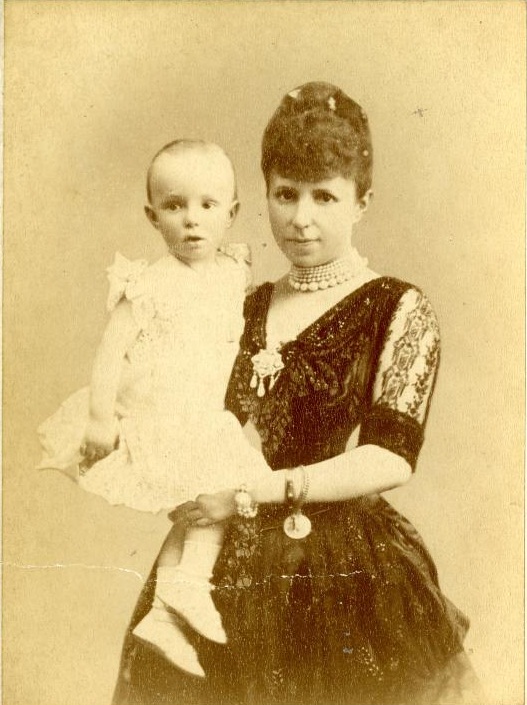
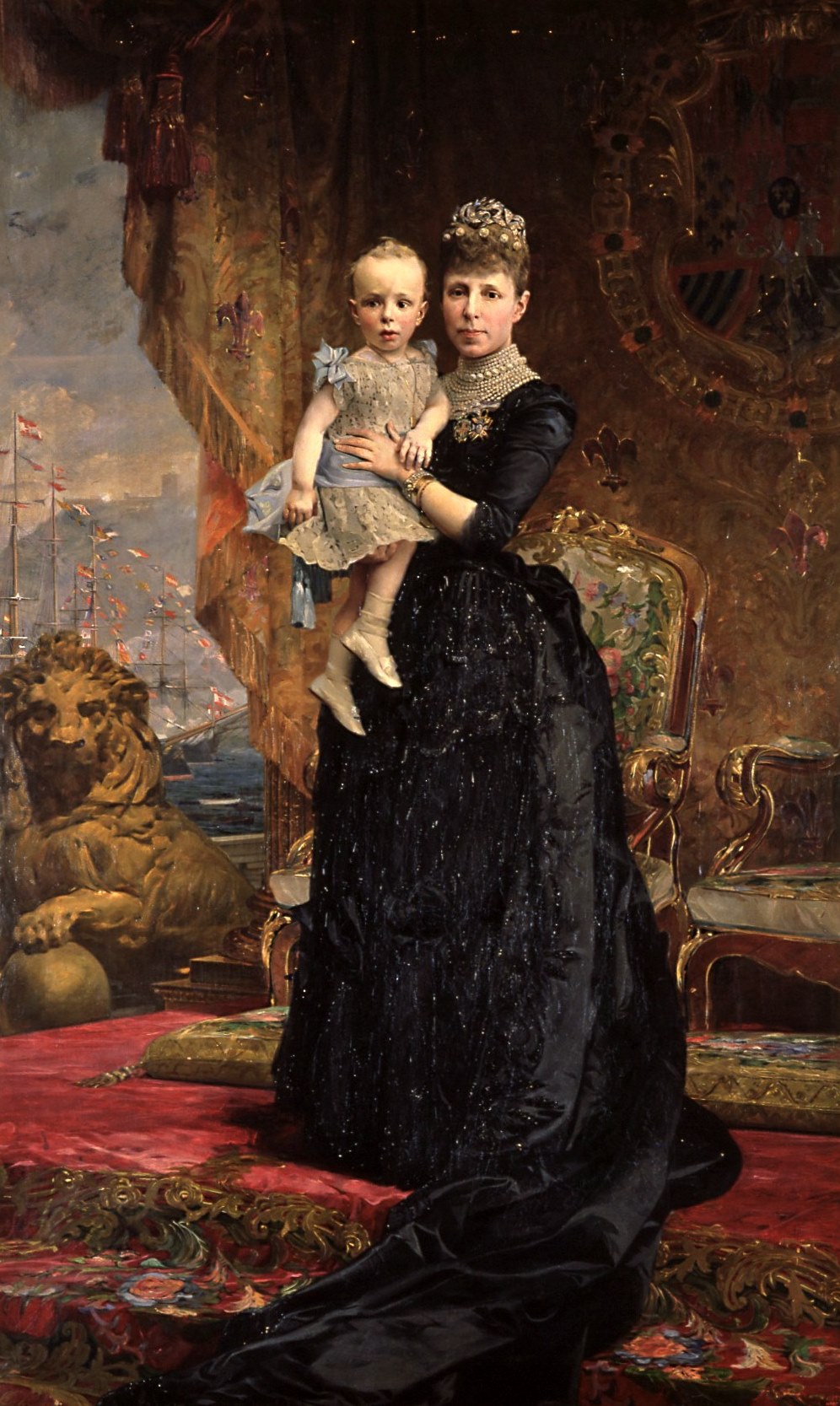
4.3. Major events and impact
The most significant and impactful events during Maria Christina's regency were the dramatic losses of Spain's remaining overseas territories following the Spanish-American War in 1898. This conflict resulted in Spain ceding Cuba, Puerto Rico, and the Philippines to the United States. This catastrophic defeat, often referred to in Spain as the "Disaster of '98," marked the definitive end of the Spanish Empire and had profound social and political consequences for the nation.
The loss of these territories deeply affected Spain's national identity, leading to a period of intense self-reflection and a re-evaluation of its role in the world. The event exposed the weaknesses of the existing political system and military, contributing to a sense of national humiliation. Despite these immense challenges, Maria Christina's steady hand as Regent helped to prevent complete political collapse. Her commitment to maintaining constitutional order provided a framework for Spain to navigate this crisis, mitigating potential revolutionary upheavals and ensuring a peaceful, albeit difficult, transition of power to her son upon his majority. Her governance during this period, while unable to prevent the imperial decline, was instrumental in preserving the monarchy itself amidst national trauma.
5. Later life and death
After her regency concluded, Maria Christina continued to play a significant, though more discreet, role within the Spanish royal family.
5.1. Life after the Regency
Following the marriage of her son, Alfonso XIII, to Victoria Eugenie of Battenberg in 1906, Maria Christina gradually adopted a secondary role in public events. Despite this, Alfonso XIII frequently sought her counsel, indicating her continued influence and his reliance on her experience and wisdom. She remained a respected figure within the court and continued to be involved in various charitable and social initiatives, maintaining her image as a dedicated public servant.
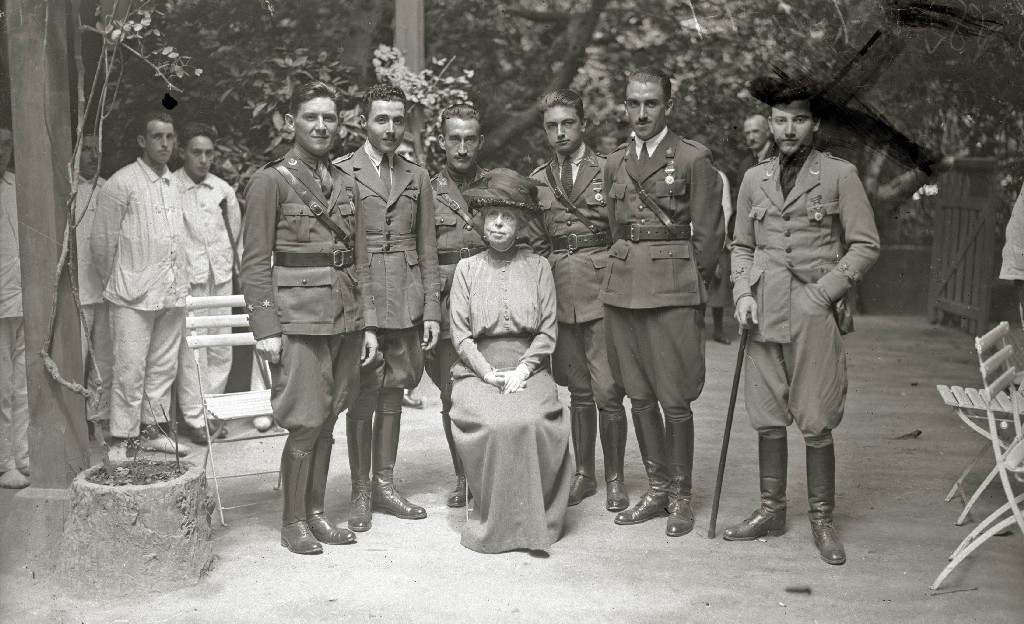
5.2. Role during World War I
During World War I (1914-1918), Maria Christina became the leading figure around whom the Germanophile faction within the Spanish Royal Court coalesced. This stance contrasted with the pro-Entente minority faction, which was notably represented by her daughter-in-law, the British-born Victoria Eugenie. Despite these internal divisions within the royal family, Spain officially maintained a policy of neutrality throughout the conflict, a position that Maria Christina implicitly supported through her influence.
5.3. Death
Maria Christina died on February 6, 1929, at the Royal Palace of Madrid, following several weeks of heart disease. She was buried at the El Escorial royal monastery, the traditional burial place for Spanish monarchs and their consorts.
Her death had a profound impact on her son, Alfonso XIII. Sir Charles Petrie, Alfonso XIII's biographer, observed that the Queen Dowager's death had a disastrous effect on her son, asserting that he never politically recovered from the blow. Indeed, within little more than two years of her passing, the Spanish monarchy itself collapsed, giving way to the Second Spanish Republic. Grand Duchess Maria Pavlovna of Russia, in her 1932 memoirs, described Maria Christina as "Queen Christine, a trim vivacious little old lady with an intelligent, sharp face and white hair. Her manner was perfectly simple and cordial, but you felt, nevertheless, that she was a sovereign of the old school, who had never stepped outside the palace walls." This description highlights her dignified demeanor and adherence to traditional royal conduct.
6. Honours and awards
Maria Christina received numerous national and international honours and decorations throughout her life, reflecting her status and diplomatic importance:
- Austria-Hungary:
- Grand Cross of the Order of Elizabeth, 1898
- Dame of the Order of the Starry Cross, 1st Class
- Restoration (Spain):
- 805th Dame of the Order of Queen Maria Luisa, September 1, 1879
- Grand Mistress of the Order of Queen Maria Luisa, November 29, 1879
- Siam:
- Dame of the Order of the Royal House of Chakri, October 18, 1897
- French Third Republic:
- Grand Cross of the Legion of Honour, November 17, 1898
- Kingdom of Portugal:
- Dame of the Order of Queen Saint Isabel, November 14, 1879
- Dame Grand Cross of the Order of the Immaculate Conception of Vila Viçosa, October 14, 1886
- Grand Cross of the Sash of the Three Orders, November 8, 1892
- Holy See:
- Golden Rose, 1886
- Empire of Japan:
- Dame Grand Cordon of the Order of the Precious Crown, February 16, 1889
- Kingdom of Bavaria:
- Dame of the Order of Saint Elizabeth, 1st Class
- Dame of Honour of the Order of Theresa
- Belgium:
- Grand Cordon of the Royal Order of Leopold, 1902
- Sovereign Military Order of Malta:
- Dame Grand Cross of Honour and Devotion, with Distinction for Jerusalem
- Ottoman Empire:
- Dame Grand Cordon of the Order of Charity
- Russian Empire:
- Dame Grand Cross of the Order of St. Catherine
- United Kingdom of Great Britain and Ireland:
- Royal Order of Victoria and Albert, 1st Class
7. Heraldry
Maria Christina's royal status was represented by distinct coats of arms during her time as Queen Consort and later as Queen Dowager, along with her personal royal monogram.
| Coat of Arms as Queen Consort | Coat of Arms as Queen Dowager | Royal Monogram |
|---|---|---|
 |  |  |
8. Genealogy
Maria Christina Henriette Desideria Felicitas Raineria of Austria was a member of the House of Habsburg-Lorraine, a prominent European royal dynasty. Her lineage can be traced back through several generations of influential monarchs and nobles.
Her parents were Archduke Karl Ferdinand of Austria and Archduchess Elisabeth Franziska of Austria. Her paternal grandparents were Archduke Charles, Duke of Teschen, a son of Leopold II, Holy Roman Emperor, and Princess Henrietta of Nassau-Weilburg. Her maternal grandparents were Archduke Joseph, Palatine of Hungary, also a son of Leopold II, and Duchess Maria Dorothea of Württemberg. This double descent from Emperor Leopold II highlights her deep roots within the Habsburg imperial family.
The following table details her ancestry for several generations:
| Generation | Name | Relationship |
|---|---|---|
| 1 | Maria Christina of Austria | Subject |
| 2 | Archduke Karl Ferdinand of Austria | Father |
| 3 | Archduchess Elisabeth Franziska of Austria | Mother |
| 4 | Archduke Charles, Duke of Teschen | Paternal Grandfather |
| 5 | Princess Henrietta of Nassau-Weilburg | Paternal Grandmother |
| 6 | Archduke Joseph, Palatine of Hungary | Maternal Grandfather |
| 7 | Duchess Maria Dorothea of Württemberg | Maternal Grandmother |
| 8 | Leopold II, Holy Roman Emperor | Paternal Great-Grandfather (also Maternal Great-Grandfather) |
| 9 | Infanta Maria Louisa of Spain | Paternal Great-Grandmother (also Maternal Great-Grandmother) |
| 10 | Frederick William, Prince of Nassau-Weilburg | Paternal Great-Grandfather |
| 11 | Burgravine Louise Isabelle of Kirchberg | Paternal Great-Grandmother |
| 12 | Leopold II, Holy Roman Emperor | Maternal Great-Grandfather (same as 8) |
| 13 | Infanta Maria Louisa of Spain | Maternal Great-Grandmother (same as 9) |
| 14 | Duke Louis of Württemberg | Maternal Great-Grandfather |
| 15 | Princess Henriette of Nassau-Weilburg | Maternal Great-Grandmother |
| 16 | Francis I, Holy Roman Emperor | Paternal Great-Great-Grandfather (also Maternal Great-Great-Grandfather) |
| 17 | Maria Theresa of Austria | Paternal Great-Great-Grandmother (also Maternal Great-Great-Grandmother) |
| 18 | Charles III of Spain | Paternal Great-Great-Grandfather (also Maternal Great-Great-Grandfather) |
| 19 | Maria Amalia of Saxony | Paternal Great-Great-Grandmother (also Maternal Great-Great-Grandmother) |
| 20 | Charles Christian, Prince of Nassau-Weilburg | Paternal Great-Great-Grandfather (also Maternal Great-Great-Grandfather) |
| 21 | Princess Carolina of Orange-Nassau | Paternal Great-Great-Grandmother (also Maternal Great-Great-Grandmother) |
| 22 | Wilhelm Georg, Count Sayn-Hachenburg | Paternal Great-Great-Grandfather |
| 23 | Princess Isabella Auguste Reuss of Greiz | Paternal Great-Great-Grandmother |
| 28 | Frederick II Eugene, Duke of Württemberg | Maternal Great-Great-Grandfather |
| 29 | Friederike Dorothea of Brandenburg-Schwedt | Maternal Great-Great-Grandmother |
9. Assessment and impact
Maria Christina's life and regency had a profound and lasting impact on Spain, particularly in her role in maintaining stability during a tumultuous period.
9.1. Positive assessment
Maria Christina is largely assessed positively for her contributions to Spanish stability and her unwavering dedication to preserving the monarchy. During her regency, she skillfully navigated the complex political landscape, ensuring a peaceful transition of power to her son, Alfonso XIII. Her rule was characterized by a deep respect for constitutional rights, and she oversaw the implementation of numerous political reforms aimed at preventing internal conflicts and maintaining order. Her personal qualities, such as her strong religious beliefs and austere demeanor, earned her the respect of many, including Pope Leo XIII, which helped to unify conservative elements and weaken support for rival factions like the Carlists. Her primary objective was to safeguard the crown for her son, a duty she fulfilled with remarkable steadfastness, providing a crucial period of continuity and institutional stability for Spain during a challenging era of political and social change.
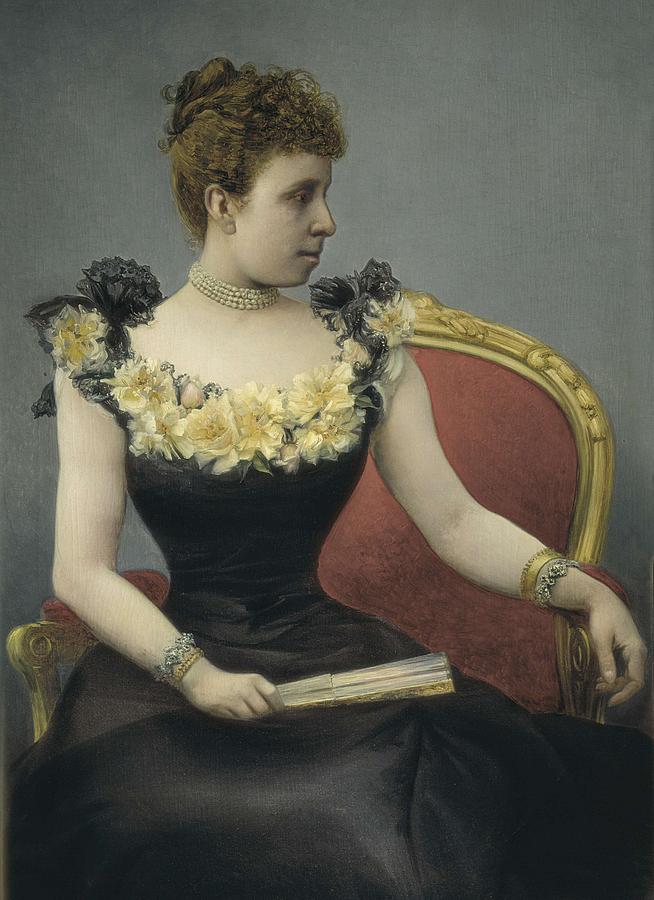
9.2. Criticism and controversy
Despite her successes in maintaining stability, Maria Christina's regency was not without its criticisms and faced significant challenges. The most notable controversy was the catastrophic Spanish-American War of 1898, which occurred under her watch and resulted in the loss of Spain's last major overseas territories: Cuba, Puerto Rico, and the Philippines. This event, known as the "Disaster of '98," was a profound national humiliation and exposed deep-seated weaknesses within the Spanish state and military. While the war's outcome was largely beyond her direct control, it became a defining negative legacy of her regency, contributing to a widespread sense of disillusionment and a re-evaluation of Spain's national identity.
Public perceptions of Maria Christina were also varied; while some admired her virtues, her reserved and disciplined nature led to nicknames like "Mary the Curt One" and "the governess," suggesting a certain detachment or lack of popular warmth. Furthermore, the political system she worked to preserve ultimately proved fragile. The collapse of the monarchy just two years after her death in 1929, as noted by her son's biographer, Sir Charles Petrie, suggests that despite her efforts, the underlying challenges to the Spanish crown were immense and ultimately insurmountable in the long term. Her passing removed a crucial stabilizing force, and the subsequent political upheaval underscores the inherent difficulties of the period she had so diligently managed.